Metabolite Profiles of Red and Yellow Watermelon (Citrullus lanatus) Cultivars Using a 1H-NMR Metabolomics Approach
Abstract
1. Introduction
2. Results and Discussion
2.1. H-NMR of the Pulp Extracts of Red and Yellow Watermelon Cultivars
2.2. Multivariate Data Analysis of the Pulp Extracts of Red and Yellow Watermelon Cultivars
2.3. Relative Quantification
3. Materials and Methods
3.1. Chemicals
3.2. Plant Material
3.3. Extraction
3.4. NMR Analysis
3.5. Data Processing and Statistical Tests
4. Conclusions
Supplementary Materials
Author Contributions
Funding
Acknowledgments
Conflicts of Interest
References
- Biancolillo, A.; Marini, F. Chemometric methods for spectroscopy-based pharmaceutical analysis. Front. Chem. 2018, 6, 1–14. [Google Scholar] [CrossRef] [PubMed]
- Bailey, N.J.C.; Oven, M.; Holmes, E.; Nicholson, J.K.; Zenk, M.H. Metabolomic analysis of the consequences of cadmium exposure in Silene cucubalus cell cultures via 1H NMR spectroscopy and chemometrics. Phytochem. 2003, 62, 851–858. [Google Scholar] [CrossRef]
- Quinta, G.; Garcı, J.C.; Agustı, A.F. Chemometric approaches to improve PLSDA model outcome for predicting human non-alcoholic fatty liver disease using UPLC-MS as a metabolic profiling tool. Metabolomics 2012, 8, 86–98. [Google Scholar] [CrossRef]
- Amorello, D.; Orecchio, S.; Pace, A.; Barreca, S. Discrimination of almonds (Prunus dulcis) geographical origin by minerals and fatty acids profiling. Nat. Prod. Res. 2016, 30, 2107–2110. [Google Scholar] [CrossRef]
- Socaci, S.A.; Socaciu, C.; Tofan, M.; Pintea, A. Chemometric discrimination of different tomato cultivars based on their volatile fingerprint in relation to lycopene and total phenolics content. Phytochem. Anal. 2014, 25, 161–169. [Google Scholar] [CrossRef] [PubMed]
- Fiehn, O. Metabolomics – the link between genotypes and phenotypes. Plant. Mol. Biol. 2002, 48, 155–171. [Google Scholar] [CrossRef] [PubMed]
- Choi, Y.H.; Kim, H.K.; Linthorst, H.J.; Hollander, J.G.; Lefeber, A.W.; Erkelens, C.; Nuzillard, J.; Verpoorte, R. NMR metabolomics to revisit the tobacco mosaic virus infection in Nicotiana tabacum leaves. J. Nat. Prod. 2006, 69, 742–748. [Google Scholar] [CrossRef]
- Widarto, H.T.; Van Der Meijden, E. Metabolomic differentiation of Brassica rapa following herbivory by different insect instars using two-dimensional nuclear magnetic resonance spectroscopy. J. Chem. Ecol. 2006, 32, 2417–2428. [Google Scholar] [CrossRef]
- Besse, P. Molecular Plant. Taxonomy, 1st ed.; Humana Press: New York, NY, USA, 2014; pp. 1–38. [Google Scholar]
- Hu, C.; Shi, J.; Quan, S.; Cui, B.; Kleessen, S.; Nikoloski, Z.; Tohge, T.; Alexander, D.; Guo, L.; Lin, H.; et al. Metabolic variation between japonica and indica rice cultivars as revealed by non-targeted metabolomics. Sci. Rep. 2014, 4, 1–10. [Google Scholar] [CrossRef]
- Fujimura, Y.; Kurihara, K.; Ida, M.; Kosaka, R.; Miura, D. Metabolomics-driven nutraceutical evaluation of diverse green tea cultivars. PLoS ONE 2011, 6, 1–16. [Google Scholar] [CrossRef]
- Kim, H.K.; Choi, Y.H.; Verpoorte, R. NMR-based metabolomic analysis of plants. Nat. Protoc. 2010, 5, 536–549. [Google Scholar] [CrossRef] [PubMed]
- Verpoorte, R.; Choi, Y.H.; Kim, H.K. NMR-based metabolomics at work in phytochemistry. Phytochem. Rev. 2007, 6, 3–14. [Google Scholar] [CrossRef]
- Ardenkjaer-Larsen, J.H.; Boebinger, G.S.; Comment, A.; Duckett, S.; Edison, A.S.; Engelke, F.; Griesinger, C.; Griffin, R.G.; Hilty, C.; Maeda, H.; et al. Facing and overcoming sensitivity challenges in biomolecular NMR spectroscopy. Angew. Chem. Int. Ed. 2015, 54, 9162–9185. [Google Scholar] [CrossRef] [PubMed]
- Jolliffe, I.T.; Cadima, J. Principal component analysis: A review and recent developments. Phil. Trans. R. Soc. 2016, 374, 1–16. [Google Scholar] [CrossRef] [PubMed]
- Worley, B.; Powers, R. Multivariate analysis in metabolomics. Curr. Metab. 2015, 1, 92–107. [Google Scholar]
- Abdelwahab, S.I. Anti-inflammatory activities of cucurbitacin E isolated from Citrullus lanatus var. citroides: Role of reactive nitrogen species and cyclooxygenase enzyme inhibition. Fitoterapia 2011, 82, 1190–1197. [Google Scholar] [CrossRef]
- Tlili, I.; Hdider, C.; Salvatore, M.; Ilahy, R.; Jebari, H.; Dalessandro, G. Bioactive compounds and antioxidant activities during fruit ripening of watermelon cultivars. J. Food Compos. Anal. 2011, 24, 923–928. [Google Scholar] [CrossRef]
- Johnson, E.J. The role of carotenoids in human health. Nutr. Clin. Care 2002, 5, 56–65. [Google Scholar] [CrossRef]
- Lv, P.; Li, N.; Liu, H.; Gu, H.; Zhao, W. Changes in carotenoid profiles and in the expression pattern of the genes in carotenoid metabolisms during fruit development and ripening in four watermelon cultivars. Food Chem. 2015, 174, 52–59. [Google Scholar] [CrossRef]
- Jayaprakasha, G.K.; Patil, B.S. A metabolomics approach to identify and quantify the phytochemicals in watermelons by quantitative 1HNMR. Talanta 2016, 153, 268–277. [Google Scholar] [CrossRef]
- Tarachiwin, L.; Masako, O.; Fukusaki, E. quality evaluation and prediction of Citrullus lanatus by 1H NMR-based metabolomics and multivariate analysis. J. Agric. Food Chem. 2008, 56, 5827–5835. [Google Scholar] [CrossRef] [PubMed]
- Stahl, W.; Sies, H. Bioactivity and protective effects of natural carotenoids. Biochim. Biophys. Acta 2005, 1740, 101–107. [Google Scholar] [CrossRef] [PubMed]
- Perkins-Veazie, P.; Collins, J.K.; Davis, A.R.; Roberts, W. Carotenoid content of 50 watermelon cultivars. J. Agric. Food Chem. 2006, 54, 2593–2597. [Google Scholar] [CrossRef] [PubMed]
- Liu, C.; Zhang, H.; Dai, Z.; Liu, X.; Liu, Y.; Deng, X.; Chen, F.; Xu, J. Volatile chemical and carotenoid profiles in watermelons [Citrullus vulgaris (Thunb.) Schrad (Cucurbitaceae)] with different flesh colors. Food Sci. Biotechnol. 2012, 21, 531–541. [Google Scholar] [CrossRef]
- Bang, H.; Davis, A.R.; Kim, S.; Leskovar, D.I.; King, S.R. Flesh color inheritance and gene interactions among canary yellow, pale yellow, and red watermelon. J. Amer. Soc. Hort. Sci. 2010, 135, 362–368. [Google Scholar] [CrossRef]
- U.S. Department of Agriculture. Available online: https://fdc.nal.usda.gov/fdc-app.html#/food-details/786754/nutrients (accessed on 29 April 2020).
- Tiziani, S.; Schwartz, S.J.; Vodovotz, Y. Profiling of carotenoids in tomato juice by one- and two-dimensional NMR. J. Agric. Food Chem. 2015, 54, 6094–6100. [Google Scholar] [CrossRef]
- Mercadante, A.Z.; Britton, G.; Rodriguez-Amaya, D.B. Carotenoids from yellow passion fruit (Passiflora edulis). J. Agric. Food Chem. 1998, 46, 4102–4106. [Google Scholar] [CrossRef]
- Azizan, A.; Ahamad Bustamam, M.S.; Maulidiani, M.; Shaari, K.; Ismail, I.S.; Nagao, N.; Abas, F. Metabolite Profiling of the microalgal diatom Chaetoceros Calcitrans and correlation with antioxidant and nitric oxide inhibitory activities via 1H NMR-based metabolomics. Mar. Drugs 2018, 16, 154. [Google Scholar] [CrossRef]
- Eh, A.L.; Teoh, S. Novel modified ultrasonication technique for the extraction of lycopene from tomatoes. Ultrason. Sonochem. 2012, 19, 151–159. [Google Scholar] [CrossRef]
- Yusof, N.A. Infrared-metabolomics approach in detecting changes in Andrographis paniculata metabolites due to different harvesting ages and times. J. Sci. Food Agric. 2015, 95, 2533–2543. [Google Scholar] [CrossRef]
- Pariyani, R.; Ismail, I.S.; Azam, A.A.; Abas, F.; Shaari, K. Identification of the compositional changes in Orthosiphon stamineus leaves triggered by different drying techniques using 1H NMR metabolomics. J. Sci. Food Agric. 2017, 97, 4169–4179. [Google Scholar] [CrossRef] [PubMed]
- Eriksson, L.; Johansson, E.; Kettaneh-Wold, N.; Trygg, J.; Wikström, C.; Wold, S. Multi- and Megavariate Data Analysis. Part 1: Basic Principles and Applications; Umetrics Academy Press: Umeå, Sweden, 2006. [Google Scholar]
- Ginsburg, S.; Tiwari, O.; Kurhanewicz, J. Variable ranking with PCA: Finding multiparametric MR imaging markers for prostate cancer diagnosis. In Prostate Cancer Imaging. Image Analysis and Image-Guided Interventions, Proceedings of the International Workshop on Prostate Cancer Imaging, Toronto, Canada, 22 September 2011; Madabhushi, A., Dowling, J., Huisman, H., Barratt, D., Eds.; Springer-Verlag: Berlin/Heidelberg, Germany, 2011; pp. 146–157. [Google Scholar]
- Ilahy, R.; Tlili, I.; Siddiqui, M.W.; Hdider, C.; Lenucci, M.S. Inside and beyond color: Comparative overview of functional quality of tomato and watermelon fruits. Front. Plant. Sci 2019, 10, 1–26. [Google Scholar] [CrossRef] [PubMed]
- Collins, J.K.; Wu, G.; Perkins-Veazie, P.; Spears, K.; Claypool, P.L.; Baker, R.A.; Clevidence, B.A. Watermelon consumption increases plasma arginine concentrations in adults. Nutrition 2007, 23, 261–266. [Google Scholar] [CrossRef] [PubMed]
- Commisso, M.; Bianconi, M.; Di Carlo, F.; Poletti, S.; Bulgarini, A.; Munari, F.; Negri, S.; Stocchero, M.; Ceoldo, S.; Assfalg, M.; et al. Multi-approach metabolomics analysis and artificial simplified phytocomplexes reveal cultivar-dependent synergy between polyphenols and ascorbic acid in fruits of the sweet cherry (Prunus avium L.). PLoS ONE 2017, 12, 1–23. [Google Scholar] [CrossRef] [PubMed]
- Faulks, R.M.; Southon, S. Challenges to understanding and measuring carotenoid bioavailability. Biochim. Biophys. Acta 2005, 1740, 95–100. [Google Scholar] [CrossRef]
- Hong, X.; Isa, N.M.; Fakurazi, S.; Ismail, I.S. Phytochemical and anti-inflammatory properties of Scurrula ferruginea (Jack) Danser parasitising on three different host plants elucidated by NMR-based metabolomics. Phytochem. Anal. 2020, 31, 15–27. [Google Scholar] [CrossRef] [PubMed]
- Yang, B.; Wang, J.; Zhao, M.; Liu, Y.; Wang, W.; Jiang, Y. Identification of polysaccharides from pericarp tissues of litchi (Litchi chinensis Sonn.) fruit in relation to their antioxidant activities. Carbohydr. Res. 2006, 341, 634–638. [Google Scholar] [CrossRef]
- Maulidiani, M. Differentiation of Nigella sativa seeds from four different origins and their bioactivity correlations based on NMR-metabolomics approach. Phytochem. Lett. 2015, 13, 308–318. [Google Scholar] [CrossRef]
Sample Availability: Sample from the compounds are not available from the authors. |
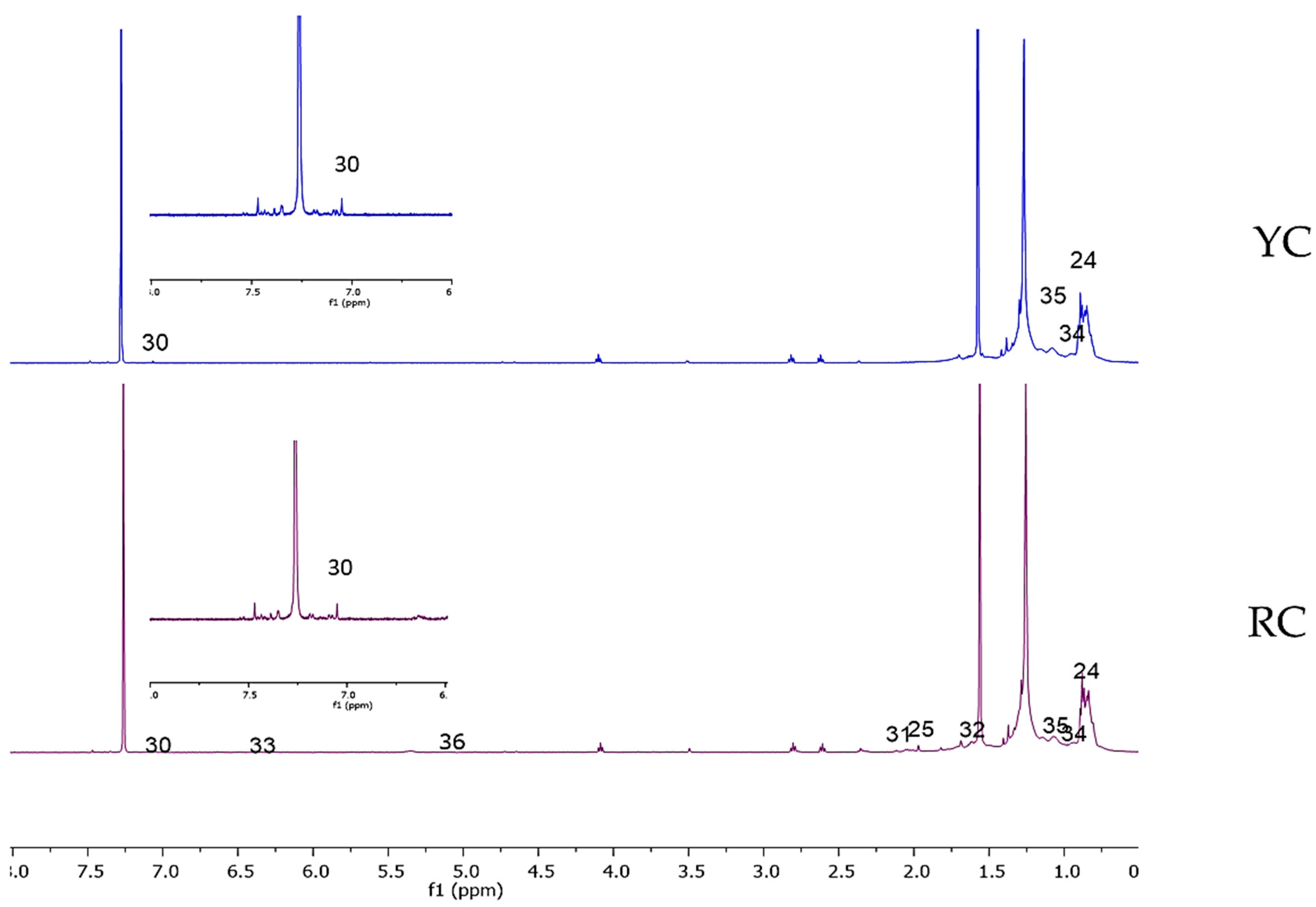
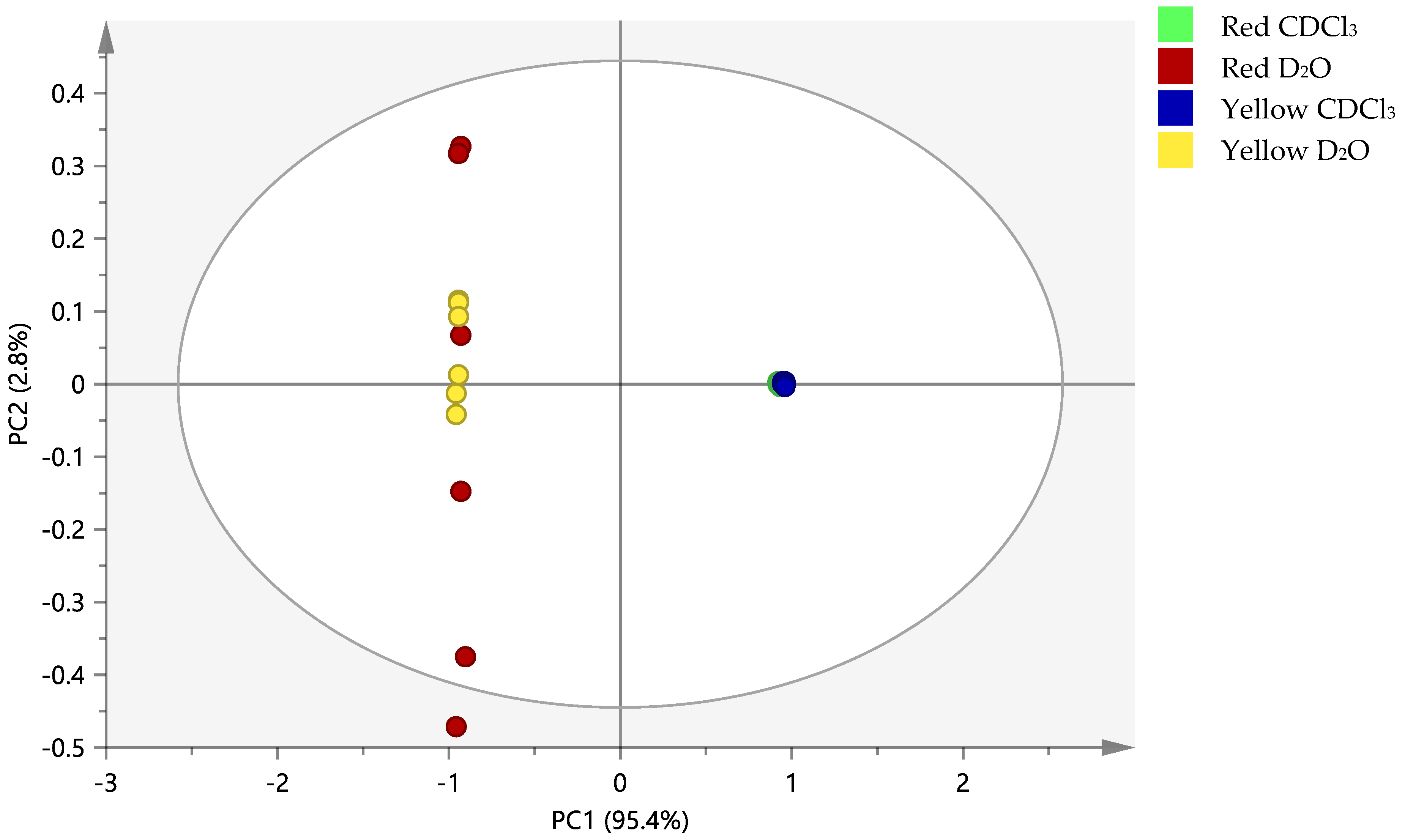
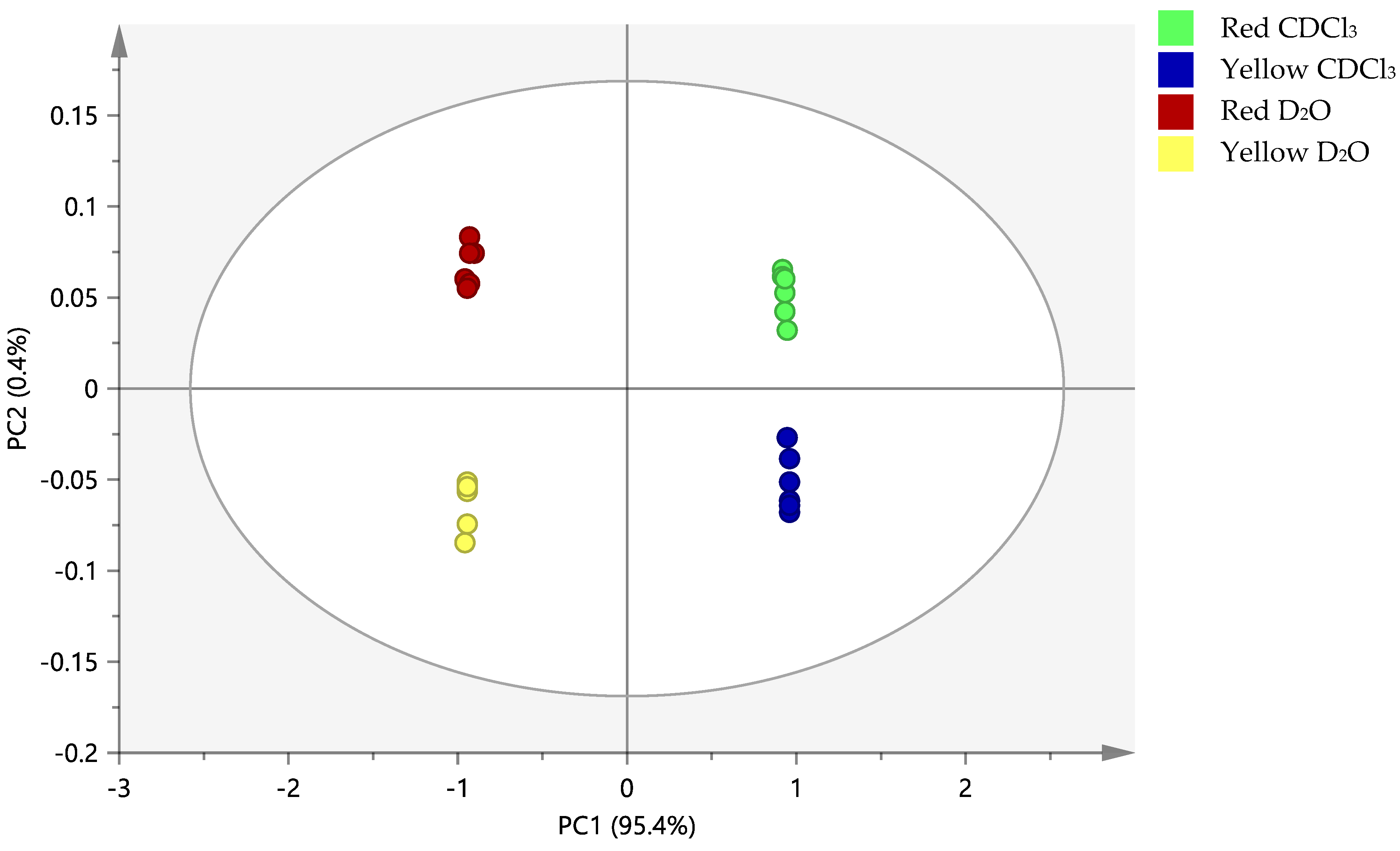
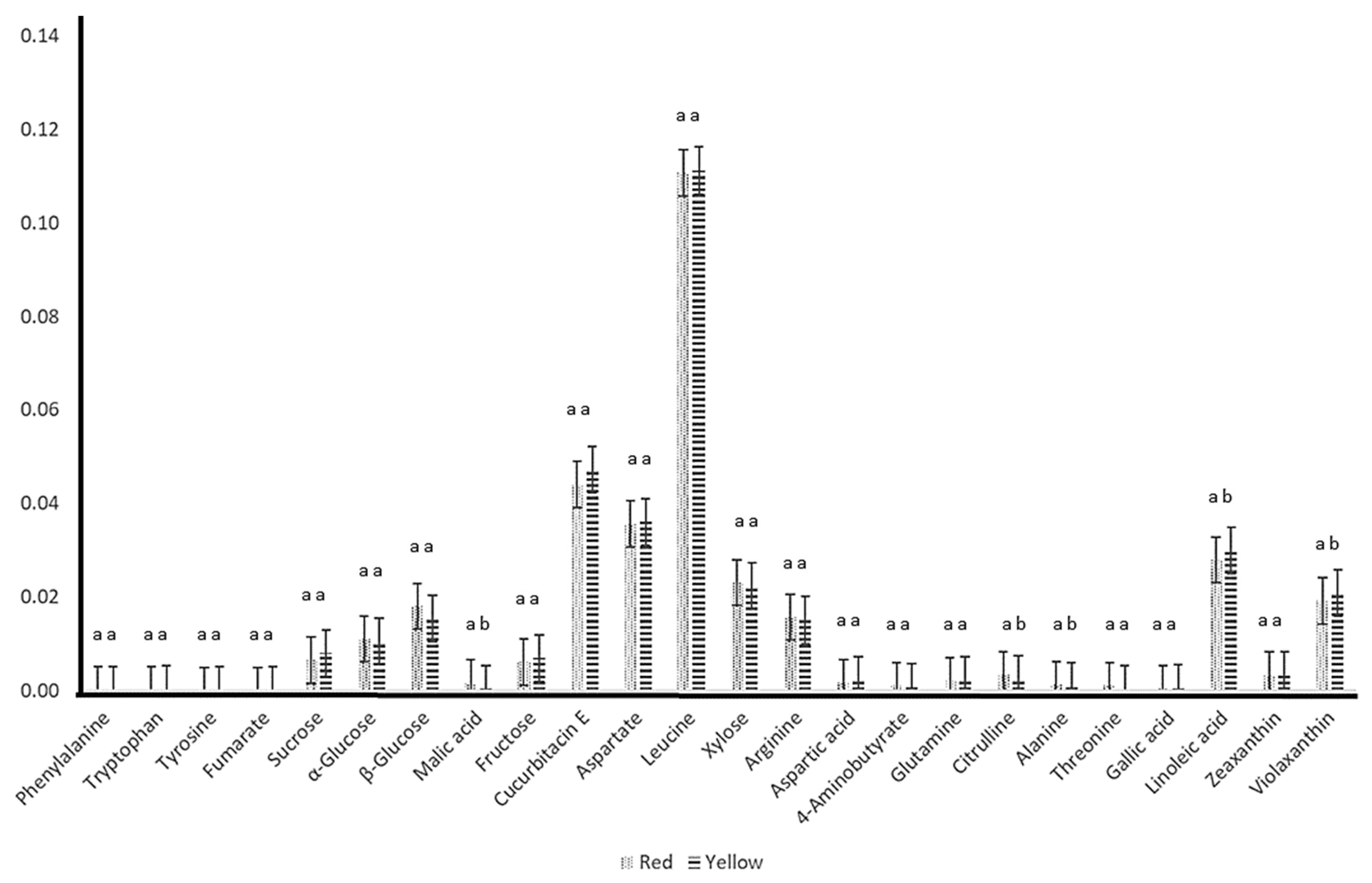
| No. | Metabolite | Chemical Shift (Multiplicity) | RW | YW | RC | YC |
|---|---|---|---|---|---|---|
| 1 | α-Glucose | 5.23 (d, J = 4.0 Hz) | + | + | - | - |
| 2 | β-Glucose | 4.64 (d, J = 8.0 Hz) | + | + | - | - |
| 3 | Sucrose | 5.41 (d, J = 4.0 Hz) | + | + | - | - |
| 4 | Fructose | 4.22 (d, J = 9.0 Hz) | + | + | - | - |
| 5 | Alanine | 1.48 (d, J = 7.5 Hz) | + | + | - | - |
| 6 | Glutamine | 2.14 (m), 2.47 (m) | + | + | - | - |
| 7 | Arginine | 3.76 (m), 1.89 (m), 1.63 (m), 3.24 (t, J = 9.0 Hz) | + | + | - | - |
| 8 | Threonine | 1.33 (d, J = 7.0 Hz) | + | + | - | - |
| 9 | Tryptophan | 7.20 (t, J = 7.0 Hz), 7.29 (t, J = 8.0 Hz), 7.32 (s), 7.54 (d, J = 8.0 Hz), 7.74 (d, J = 8.0 Hz) | + | + | - | - |
| 10 | Tyrosine | 7.19 (t, J = 7.0 Hz), 6.90 (m) | + | + | - | - |
| 11 | Valine | 0.99 (m), 1.04 (d, J = 7.0 Hz) | + | + | - | - |
| 12 | Leucine | 3.72 (t, J = 4.0 Hz), 0.93 (d, J = 7.5 Hz), 0.96 (m) | + | + | - | - |
| 13 | Isoleucine | 1.01 (m), 0.94 (m) | + | + | - | - |
| 14 | Citrulline | 3.15 (t, J = 7.0 Hz), 1.58 (m), 3.76 (m) | + | + | - | - |
| 15 | Acetate | 1.91 (s) | + | + | - | - |
| 16 | Citrate | 2.50 (d, J = 8.0 Hz), 2.70 (dd, J = 15.5, 3.5 Hz) | + | + | - | - |
| 17 | Fumarate | 6.53 (s) | + | + | - | - |
| 18 | Phenylalanine | 7.33 (m), 7.39 (m), 7.43 (m) | + | + | - | - |
| 19 | 4-Aminobutyrate | 2.31 (t, J = 7.5 Hz), 3.01 (t, J = 7.5 Hz) | + | + | - | - |
| 20 | Malic acid | 4.32 (dd, J = 10.0, 3.5 Hz), 2.70 (dd, J = 15.5, 3.5 Hz), 2.82 (dd, J = 18.0, 4.5 Hz) | + | + | - | - |
| 21 | Aspartate | 2.70 (dd, J = 15.5, 3.5 Hz), 2.82 (dd, 18.0, 4.5 Hz), 3.90 (dd, J = 10.5, 3.5 Hz) | + | + | - | - |
| 22 | Xylose | 3.39 (t, J = 9.5), 4.54 (d, J = 19.5 Hz), 5.19 (m) | + | + | - | - |
| 23 | Ascorbic acid | 4.54 (d, J = 19.5 Hz) | + | + | - | - |
| 24 | Linoleic acid | 0.88 (m), 1.17 (m) | - | - | + | + |
| 25 | Acetic acid | 1.97 (s) | - | - | + | - |
| 26 | Succinic acid | 2.48 (s) | + | + | - | - |
| 27 | Aspartic acid | 2.82 (dd, J = 18.0, 4.5 Hz), 2.65 (d, 7.5) | + | + | - | - |
| 28 | Cucurbitacin E | 6.08 (s), 4.65 (d, 8.0), 4.02 (m), 2.07 (m) | + | + | - | - |
| 29 | Formic acid | 8.51 (s) | + | + | - | - |
| 30 | Gallic acid | 7.05 (s) | - | - | + | + |
| 31 | Lycopene | 6.17–6.68 (m), 5.95 (m), 5.11 (bs), 2.11 (bs), 2.00 (bs), 1.82 (s), 1.68 (s), 1.62 (s) | - | - | + | - |
| 32 | β-Carotene | 1.49 (s), 1.62 (s), 1.72 (s), 2.03 (s), 6.17 (s), 6.19 (s) | - | - | + | - |
| 33 | Lutein | 6.36 (d, J = 15.0 Hz), 6.25 (d, J = 15.5 Hz), 1.97 (s), 1.01 (s), 0.87 (s) | - | - | + | - |
| 34 | Violaxanthin | 1.97 (s), 1.95 (s), 1.15 (s), 0.94 (s) | - | - | + | + |
| 35 | Zeaxanthin | 1.97 (s), 1.98 (s), 1.77 (s), 1.07 (s) | - | - | + | + |
| 36 | Prolycopene | 5.09 (m), 6.30 (m), 6.47 (m), 6.25 (d, J = 15.5 Hz), 1.64 (s), 1.56 (s), 1.97 (s) | - | - | + | - |
| Sample | Crude Extract Weight (g) | Water Loss (g) |
|---|---|---|
| Red watermelon | 8.45 ± 0.34 a | 381.86 ± 1.78 a |
| Yellow watermelon | 9.18 ± 0.07 b | 380.05 ± 1.88 a |
© 2020 by the authors. Licensee MDPI, Basel, Switzerland. This article is an open access article distributed under the terms and conditions of the Creative Commons Attribution (CC BY) license (http://creativecommons.org/licenses/by/4.0/).
Share and Cite
Sulaiman, F.; Ahmad Azam, A.; Ahamad Bustamam, M.S.; Fakurazi, S.; Abas, F.; Lee, Y.X.; Ismail, A.A.; Mohd Faudzi, S.M.; Ismail, I.S. Metabolite Profiles of Red and Yellow Watermelon (Citrullus lanatus) Cultivars Using a 1H-NMR Metabolomics Approach. Molecules 2020, 25, 3235. https://doi.org/10.3390/molecules25143235
Sulaiman F, Ahmad Azam A, Ahamad Bustamam MS, Fakurazi S, Abas F, Lee YX, Ismail AA, Mohd Faudzi SM, Ismail IS. Metabolite Profiles of Red and Yellow Watermelon (Citrullus lanatus) Cultivars Using a 1H-NMR Metabolomics Approach. Molecules. 2020; 25(14):3235. https://doi.org/10.3390/molecules25143235
Chicago/Turabian StyleSulaiman, Fadzil, Amalina Ahmad Azam, Muhammad Safwan Ahamad Bustamam, Sharida Fakurazi, Faridah Abas, Yee Xuan Lee, Atira Adriana Ismail, Siti Munirah Mohd Faudzi, and Intan Safinar Ismail. 2020. "Metabolite Profiles of Red and Yellow Watermelon (Citrullus lanatus) Cultivars Using a 1H-NMR Metabolomics Approach" Molecules 25, no. 14: 3235. https://doi.org/10.3390/molecules25143235
APA StyleSulaiman, F., Ahmad Azam, A., Ahamad Bustamam, M. S., Fakurazi, S., Abas, F., Lee, Y. X., Ismail, A. A., Mohd Faudzi, S. M., & Ismail, I. S. (2020). Metabolite Profiles of Red and Yellow Watermelon (Citrullus lanatus) Cultivars Using a 1H-NMR Metabolomics Approach. Molecules, 25(14), 3235. https://doi.org/10.3390/molecules25143235







